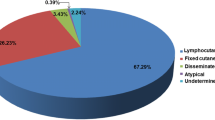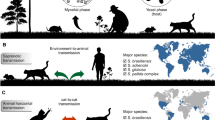Summary
Applying the concept of ‘epidemiological chain’, it is successively analyzed: the etiologic agent, Sporothrix schenckii and its natural reservoirs (sources of infection); the different ways that infecting particles may reach man (mechanisms of infection); the susceptible population and the population at risk; the incidence and distribution by sex and age in countries of Latin America; the prevalence of the disease according to clinical cases in dermatological clinics and the variation of incidence rates in some countries with time; the influence of the environment mainly climatic conditions on the geographic distribution of the disease.
Finally, according to Mackinnon's hypothesis, the climate could have a determining role on the predominance of a certain clinical form on another in different countries.
Similar content being viewed by others
References
Mackinnon JE, Influencia de las condiciones ambientales sobre la esporotricosis. Actas finales V Cong Iber Lat Amer Derm, Buenos Aires 1963; 287–90.
Mackinnon JE, Conti Díaz IA, Gezuele E, Civila E & da Luz Silvia. Isolation of Sporothrix schenckii from nature and considerations on its pathogenicity and ecology. Sabouraudia 1969; 7: 38–45.
Goodman NL. Sporotrichosis. In: Occupational Mycoses. Edited by Arthur F. DiSalvo. Lea & Febiger, Philadelphia, 1983.
Conti Díaz IA. Sporotrichosis in Uruguay: Epidemiologic and clinical aspects. In: Superficial cutaneous and subcutaneous infections. V. Inter, Conf. on the Mycoses. PAHO Scient Publ N∘ 396, Caracas, Venezuela, 1980.
Mariat F. The epidemiology of the mycoses: some comments in relation to a particular case of sporotrichosis. In: Ciba Foundation Symposium on Systemic Mycoses 1968; 144–50.
Mayorga R, Cáceres A, Toriello C, Gutiérrez C, Alvarez O, Ramírez MA & Mariat F. Étude d'une zone d'endemie sporotrichósique au Guatemala. Sabouraudia 1978; 16: 185–98.
Martino O. Esporotricosis humana por mordedura de iguana. A propósito de un caso. Rev Argent Micol 1986; 9 (2): 23–25.
Lavalle P. Esporotricosis. In: Desarrollo y estado actual de la Micología Médica en México. Simposio Syntex, Instituto Syntex edit., México, 1979; pp. 115–38.
Albornoz MB de, de Torres ED, Villanueva E. Esporotricosis. Características epidemiológicas, clínicas e inmunológicas de 215 casos (1962–1985) estudiados en la Sección de Micología. Proc. Reunión Anual (XXII) de la Sociedad de Dermatología, 1986.
Londero AT, Fischman O, Ramos CD. A esporotricose no Rio Grande do Sul (Observaçoes no interior dêsse Estado). O Hospital 1963; 63: 231–5.
Ramos e Silva. Lavai méd, 34: 739–43, 1963. Citado por F. Mariat en: Epidemiology of the mycosis: some comments in relation to a particular case of sporotrichosis. CIBA Foundation Symposium on Systemic Mycoses 144-50, 1968.
Mesa Cock J, Gómez Sierra H. y Giraldo B. Esporotricosis epidémica. Medicina Cutánea. Año V 1971; 5: 337–40.
Velez H, Santamaría L, Guzmán G y Escobar M. Esporotricosis Aspectos clínicos en 78 pacientes. Acta Médica Colombiana 1984; 9: 146–9.
Indacochea S, Flores A, Bustamante B, De La Fuente J, Holgado W, y Schrettenbrunner A. The high altitude sporotrichosis in Peru. En: Abstracts X Congress of ISHAM, Barcelona, 1988. Rev. Ibérica de Micología 1988; 5.
González Ochoa, A. Contribuciones recientes al conocimiento de la esporotricosis. Gac méd mex 1965; 95: 463–74.
Marín G, Alvarado E y Jaramillo O. Clinical observations on sporotrichosis in Costa Rica. En: Abstracts X Congress of ISHAM, Barcelona, 1988. Rev Ibℰica de Micología 1988; 5.
Lacaz C. da S. Información personal.
Conti Díaz IA. Esporotricosis, Micetomas, cromomicosis. In: Micosis que afectan piel y mucosas, pp 74–93, Ed. Doyma S.A. 1987.
Mariat F, Lavalle, P y Destombes P. Recherches sur la sporotrichose. Etude mycologique et pouvoir pathogene de souches mexicaines de Sporotrichum schenckii. Sabouraudia 1962; 2: 60–79.
Mackinnon JE. Regional peculiarities of some deep mycoses. Mycopathologia et Mycologia Applicata 1972; 46: 249–65.
Llerena J. Micosis subcutaneas en El Salvador. Esporotricosis. Cromoblastomicosis. Micetomas. Rev Inst Investig Méd (Hospital Rosales, San Salvador, El Salvador) 1975; 4: 83–97.
Mackinnon JE & Conti Díaz IA. The effect of temperature on sporotrichosis. Sabouraudia 1962; 2: 56–9.
Mackinnon JE, Conti Díaz IA & Yarzábal L. Experimental sporotrichosis, ambient temperature and amphotericin B Sabouraudia 1964; 3: 192–4.
Galiana J & Conti Díaz IA. Healings effects of heat and a rubefacient on nine cases of sporotrichosis. Sabouraudia 1963; 3: 64–71.
Roberts SOB. Treatment of superficial and subcutaneous mycoses. In: Speller DCE ed. Antifungal chemotherapy. John Wiley & Sons, Chichester, 1980.
Author information
Authors and Affiliations
Rights and permissions
About this article
Cite this article
Díaz, I.A.C. Epidemiology of sporotrichosis in Latin America. Mycopathologia 108, 113–116 (1989). https://doi.org/10.1007/BF00436061
Issue Date:
DOI: https://doi.org/10.1007/BF00436061




